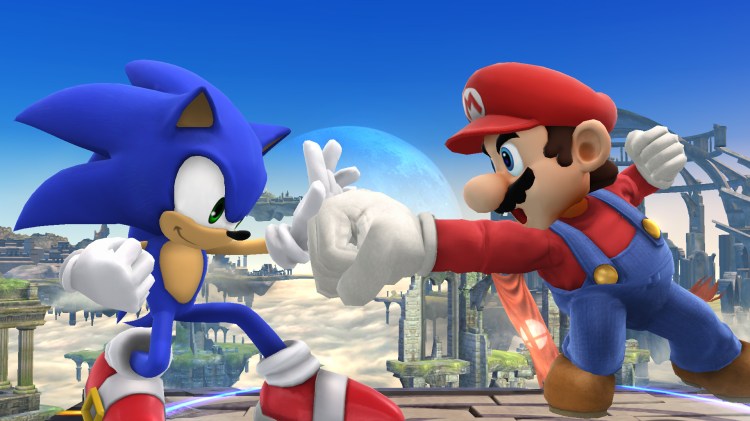The biggest retailer in the world’s profits were once so interlinked with Nintendo that it didn’t want anything to do with Sega or any other game-hardware company.
That’s just one of a few dozen interesting tidbits I learned while reading the upcoming book Console Wars: Sega, Nintendo, and the Battle That Defined a Generation. In the 500-plus page tome, author Blake J. Harris guides readers through the various battles of Nintendo and Sega. He conducted more than a hundred interviews and brings a narrative style of storytelling that reveals a number of amazing facts that I either didn’t know or had long forgotten about the dominant gaming corporations of the late 1980s through the 1990s. It all makes for an incredibly gripping read that feels much shorter than its actual length because of how difficult it is to put down. That’s also one of the main reasons that Hollywood announced plans to have Superbad writers Seth Rogen and Evan Goldberg turn the story into a feature film.
Console Wars is due to hit book stores, both physical and digital, May 13. I’ve been reading and enjoying it over the last few weeks, and I wanted to share a handful of other interesting things I learned about the 16-bit gaming kings.
For example, Walmart barely even wanted to speak to Sega of America, let alone stock its Genesis system back in the early days of the 16-bit console’s life in the U.S. This was for multiple reasons — but particularly because the Nintendo Entertainment System and its software represented nearly a 10th of the Arkansas-based retailer’s profits. Of course, having Sega probably would have made Walmart even more money — so, why did it turn down Sega of America president Tom Kalinske when he asked them to make an order?
Because Nintendo was scary as hell.
The NES manufacturer once threatened to stop filling orders for any retailers that stocked games from rogue third-party manufacturer Tengen, which released unlicensed software for the NES in an effort to avoid Nintendo’s strict contracts. Nintendo’s threat was enough to convince every retailer to stop selling Tengen games, and it rippled through the industry and convinced companies like Walmart to avoid making decisions that might upset Nintendo … like stocking the Genesis.
Here’s some of the other things I learned while reading the book:
To get into Walmart, Sega took over the retailer’s hometown
Kalinske and Sega had a problem. Retailers weren’t interested in the Sega Genesis, so instead of going from chain to another in an effort to get what he could, the Sega boss decided to focus on Walmart.
That didn’t pan out for all of the reasons noted above, but that’s when Kalinske and one of his partners came up with a plan to cover Bentonville, Ark., the home of Walmart’s headquarters, with advertisements for the Genesis. The hardware company even rented out a storefront where consumers in town could come in and check out the Genesis, but they couldn’t buy one. The idea was that everyone would go to Walmart and ask for the new, amazing system only to find out they didn’t have it — and ask why not.
This didn’t work … at first.
After months of rejection, Kalinske finally received a call from Walmart’s head of electronics. He gave in after explaining that his bosses kept pestering him about why they weren’t carrying the Genesis. The Sega boss agreed to close the store and take down all of the advertising. And other retailers started falling into line behind Walmart.
Sega of America boss Tom Kalinske was integral to Barbie, Flintstone vitamins, and He-Man
Before joining Sega of America as its chief executive officer, Kalinske worked as CEO of Mattel. Before that, he was a marketing whiz at health-supplement company Miles Laboratories.
While at Miles, Kalinske came up with a way for the vitamin maker to expand its market. He believed that a supplement that tasted pleasant and featured a property that children recognized could do well. That’s how he and his team came up with Flintstones Chewable Vitamins, which was a hit with kids and parents when it hit the market in 1968. The product remains the top-selling vitamin for children today.
His work at Miles eventually helped his get his position with Mattel. Early in his tenure at the toy company, Barbie sales were starting to slip for the first time in history, and most people predicted the blonde toy for girls would fade into obscurity. Kalinkse came up with a plan that would introduce a variety of different Barbie dolls all throughout the year that would appeal to different interests and budgets. This completely reinvigorated the Barbie brand and has helped it maintain its success through to today.
It didn’t end with vitamins and Barbies. Kalinske was also crucial in the development of He-Man and other iconic toys.
“I was shocked to learn that before he even joined Sega, Tom Kalinske had been responsible for such a large part of my childhood,” Harris told GamesBeat. “From Flintstones Chewable Vitamins and Matchbox cars, to He-Man and Pee Wee Herman dolls, the man’s behind-the-scenes influence shaped an entire generation.”

